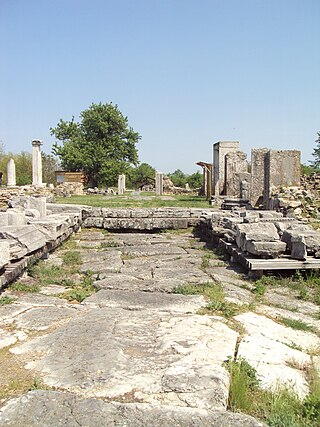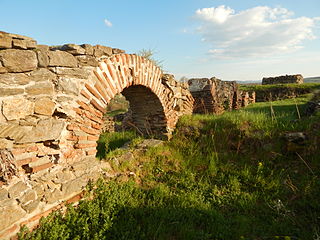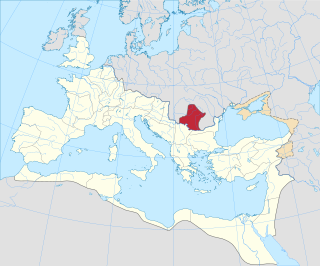
Moesia was an ancient region and later Roman province situated in the Balkans south of the Danube River. As a Roman domain Moesia was administered at first by the governor of Noricum as 'Civitates of Moesia and Triballia'. It included most of the territory of modern eastern Serbia, Kosovo, north-eastern Albania, northern parts of North Macedonia, Northern Bulgaria, Romanian Dobruja and small parts of Southern Ukraine.

The Diocese of Sofia and Plovdiv is a Latin diocese of the Catholic Church which includes the whole southern part of Bulgaria. The remainder of Bulgaria falls within the Diocese of Nicopoli. The diocese is exempt, i.e. immediately subject of the Holy See, not part of any ecclesiastical province.

Oescus, Palatiolon or Palatiolum was an important ancient city on the Danube river in Roman Moesia. It later became known as Ulpia Oescus. It lay northwest of the modern Bulgarian city of Pleven, near the village of Gigen.

In Roman literature of the early 1st century CE, the Moesi appear as a Paleo-Balkan people who lived in the region around the Timok River to the south of the Danube. The Moesi do not appear in ancient sources before Augustus's death in 14 CE and are mentioned only by three authors dealing with the Roman warfare in the region and the ethnonymic situation between mid-1st century BC and mid-1st century CE: Ovid, Strabo and Livy. Recent research suggests that a Paleo-Balkan people known as the Moesi never actually existed but the name was transplanted from Asia Minor Mysians to the Balkans by the Romans as an alternative name for the people who lived in the later province of Moesia Superior as Dardani communities. This decision in Roman literature is linked to the appropriation of the name Dardani in official Roman ideological discourse as Trojan ancestors of the Romans and the creation of a fictive name for the actual Dardani who were seen as barbarians and antagonists of Rome in antiquity.
Justiniana Prima was an Eastern Roman city that existed from 535 to 615 CE, near modern Lebane in the Leskovac region, Serbia. It is currently an archaeological site. Founded by Emperor Justinian I (527-565), it was the metropolitan seat of the newly founded Archbishopric of Justiniana Prima, which became the main church administrative body of the central Dardania with jurisdiction from Praevalitana to Dacia Ripensis. Justinian Prima was originally designed to become the capital of the prefecture of Illyricum, but for reasons likely related with its status near the Roman frontiers of the 6th century CE, Thessaloniki was preferred. It was abandoned less than 100 years after its foundation.

Nicopolis ad Istrum or Nicopolis ad Iatrum was a Roman and Early Byzantine town.

Dacia Ripensis was the name of a Roman province in the northern Balkan peninsula, immediately south of the Middle Danube. Its capital was Ratiaria. It was a district less urban than neighbouring Dacia Mediterranea and more militarized; "military camps and forts, rather than cities, were typical of the province". Besides Ratiaria, Oescus was the major settlement.

Dacia Mediterranea was a late antique Roman province, whose capital city was Serdica.

Dacia Aureliana was a province in the eastern half of the Roman Empire established by Roman Emperor Aurelian in the territory of former Moesia Superior after his evacuation of Dacia Traiana beyond the Danube in 271. Between 271/275 and 285, it occupied most of what is today northwestern Bulgaria and eastern Serbia. Its capital was in Serdica.

The Diocese of Dacia was a diocese of the later Roman Empire, in the area of modern western Bulgaria, central Serbia, Montenegro, Kosovo, northern Albania and northern North Macedonia. It was subordinate to the Praetorian prefecture of Illyricum. Its capital was at Serdica.

Praevalitana was a Late Roman province that existed between c. 284 and c. 600. It included parts of present-day Montenegro, Albania, and part of present-day Kosovo. Its capital city was Doclea, later Scodra.

Dardania was a Roman province in the Central Balkans, initially an unofficial region in Moesia (87–284), and then a province administratively part of the Diocese of Moesia (293–337). It was named after the tribe of the Dardani who inhabited the region in classical antiquity prior to the Roman conquest. During the late Imperial period the Dardanian territory was the homeland of many Roman emperors, notably Constantine the Great and Justinian I.
Palladius of Ratiaria was a late 4th century Arian Christian theologian, based in the Roman province of Dacia in modern Romania.

Archbishopric of Justiniana Prima was a Christian autonomous Archbishopric with see in the city of Justiniana Prima and jurisdiction over the Late Roman Diocese of Dacia in central parts of the Southeastern Europe.

The Diocese of Moesia was a diocese of the later Roman Empire, in the area of modern western Bulgaria, central Serbia, Montenegro, Albania, North Macedonia, and Greece.

Roman Dacia was a province of the Roman Empire from 106 to 271–275 AD. Its territory consisted of what are now the regions of Oltenia, Transylvania and Banat. During Roman rule, it was organized as an imperial province on the borders of the empire. It is estimated that the population of Roman Dacia ranged from 650,000 to 1,200,000. It was conquered by Trajan (98–117) after two campaigns that devastated the Dacian Kingdom of Decebalus. However, the Romans did not occupy its entirety; Crișana, Maramureș, and most of Moldavia remained under the Free Dacians.

Moesia Prima was a frontier province of the Late Roman Empire, situated in the central parts of present-day Serbia, along the south bank of the Danube River. Provincial capital was Viminacium, near modern Kostolac in Serbia).

Archar is a village in Bulgaria, located on the Archar river in the Vidin province. In Roman times the town of Ratiaria, from which the name derives, has been an important port on the Danube. The present day locality has been developing closer to the main road between Vidin and Lom. A fair is held in Archar on the first Saturday and Sunday of August.


























